Friday 29 November 2018
Catching the 7am Silk Air flight from Singapore we landed In Phnom Penh just after 9am.
With a population of around 2 million and growing fast, Phnom Penh is situated on the Mekong River with waters starting in Tibet over 4000 kms away. The river plays a huge part in the economy in both irrigation and transport.
Traffic here, like in many cities in this part of the world, is diabolical, taking us 45 minutes to travel the 10km to the hotel. Motorcycles and tuk-tuks weave their way amongst the cars. It’s not uncommon to see 4 on a motorbike; women sit side-saddle on the back, often nursing an infant or two on their knees.
Checking in to the La Rose Suites in Street 21 we were impressed by the friendliness of the staff. A letter in the room explained how the hotel is part of an organisation that lifts children from poverty, often recruiting children from the dumps and educating them into jobs that in turn ensures their future welfare. It has pretty neat door handles too.
After a nice lunch in the hotel restaurant a driver picked us up and drove us out into the countryside. I don’t think I have seen as much rubbish and litter on the roadsides in any other country. Lots are really bad but this place is worse.
Arriving at our destination we brought tickets and an audio guide as we passed through the gates of the Choeung Ek camp, one of the 300 plus “killing fields” that existed during the Khmer Rouge reign between 17 April 1975 to 1979. Starting at station 1 we followed the audio guide through. Basically people arrived here by truck from S21 (more about that later). They were restrained in the truck, counted and checked off before being executed that night, while loud propaganda-type-music played to cover up the noise. Pits were dug and people led to the edge then killed, not by a bullet but by blunt or sharp object trauma to the skull. Hammers, bars, bamboo poles and other such tools were used. Sometimes their throats were cut with the fronds from a palm tree.
In the last few years there has been a boardwalk built to walk amongst the pits. There is a picturesque pond at the back in which skeletons still remain. Although an effort has been made to exhume most of the 20,000 people executed here, during the rainy season bones and clothing still come to the surface. These are collected and displayed in glass cases.
Various pits have different significance. In one, woman and babies were found; the babies had been killed by holding their feet and banging their heads on the tree.
In another, the skeletons were headless; these were Khmer Rouge who were executed for not following the rules. “It is better to execute a few innocent people rather than let one guilty one get away” was the policy here in those terrible days. In the beginning people were stripped naked prior to execution and the executions carried out the night they arrived, but as numbers increased people were often held in a shed in shackles for a day or two and their clothing left on to speed up the process.
This is the most I have ever listened to an audio guide as at the end of each station there are personal accounts from both the very few that somehow survived this ordeal or other similar situations and the odd guard that was here as an executioner. The last stop is the Stupor (shrine), which contains some 20 thousand skulls and other major body bones. It’s a squeeze to move around looking up at the many shelves of skulls. On some of the lower shelves skulls contain colour coded dots to indicate which type of instrument was used in the execution.
A look at the museum on the grounds concluded our tour, after which we headed back to town to visit the Toul Sleng School that became camp S21, or really a death row, where one came to be tortured and confess one’s guilt before being executed. 12,273 prisoners were detained here, of which only 7 survived.
Once again we set off with an audio guide. Just inside the compound there are 16 gravestones for the last victims, who were found shackled and executed as the Khmer Rouge withdrew near the end of the war. We then head into building one, where three floors of classrooms were used as torture rooms. Gruesome pictures on the walls displayed the terrible ordeals suffered by these victims. Strict rules had to be followed by the victims many of whom were academics and business people.
Outside was what was once a rope climbing area for the kids but at S21 it was used to haul people up by their wrists, which were tied behind their backs. When they passed out their heads were dunked in urns of excrement to wake them up before the process was repeated.
Next we moved to building B where the ground floor is used to display firstly pictures of the Khmer Rouge regime bosses, then many people who were both victims and guards.
There is one New Zealander there who’s brother gives a very moving account of how he reacted to the torture by basically taking the piss out of his captors by giving the name of his CIA handler as Colonel Sanders (the founder of Kentucky Fried Chicken). He gave names of family friends and his mother as his CIA associates.
We moved on to building C, which had holes knocked through the walls between classrooms so guards could patrol the small brick cells built to house one or two individuals.
Lastly building four contained various exhibits from the site. The last room contains the skulls of those buried in the grounds before they ran out of space and started moving people to Choeung Ek.
Having now visited a few genocide sites I always come away wondering how these situations evolve. After a lot of reading, much of it quite contradictory (due to poor record keeping) this is my interpretation:
In 1953 Cambodia gained independence from the French, who had ruled for around a hundred years. They handed power to Norodom Sihanouk the king of Cambodia. In 1955 Sihanouk abdicated, handing power to his father, so he could become a politician, and formed the political organisation Sangkum, which won the 1955 general election. As Prime Minister, he governed Cambodia under one-party rule, suppressed political dissent, and declared himself Head of State in 1960. Officially neutral in foreign relations, in practice he was closer to the communist bloc.
Meanwhile in 1965 the Americans started bombing the eastern part of of the country where the North Vietnamese Army and Viet Kong had camps close to the boarder of South Vietnam.
In 1970, backed by the Americans, Sihanouk was ousted by the right wing Lon Not. Sihanouk went into exile in China.
In the background Pol Pot and his Khmer Rouge were gathering strength, using the American bombing of civilians in Eastern Cambodia to market their anti Lon Nol and US campaign. A CIA report at the time sums up what was taking place:
“The [Khmer Rouge] cadre tell the people the Government of Lon Nol has requested the airstrikes and is responsible for the damage and the “suffering of innocent villagers” in order to keep himself in power. The only way to stop “the massive destruction of the country” is to remove Lon Nol and return Prince Sihanouk to power. (Sihanouk did return but after a year was put under house arrest until 1979). The proselyting cadres tell the people that the quickest way to accomplish this is to strengthen KR forces so they will be able to defeat Lon Nol and stop the bombing.”
It appears that the US bombing ceased in 1973 but Pol Pot and the Khmer Rouge, when they took Phnom Penh on the 17 April 1975, were still able to convince people to pack up and leave the city telling them it was going to be bombed by the US, the idea being to disestablish the cities and send people back to the land. Those that didn’t go voluntarily were forced or executed. The intent was to triple the rice production to buy arms and supplies from China. These folks from the cities had no farming skills and the whole thing was a massive failure, with many dying from starvation and disease. This was also the period that so many were tortured and executed in what have become known as the ‘killing fields”.
Meanwhile over the next four years many Khmer Rouge troops were deserting and joining with the Vietnamese army that came to the rescue, invading Cambodia on December 25 1978. Phnom Penh was liberated on the 7 January 1979. Pol Pot and his evil band fled to the jungle of the Thai boarder where he still lead, and was recognised as leader by the UN for a number of years.
It’s all a bit hard to figure out why the world stands by and lets these events take place. Just recently our Prime Minister was pictured getting all friendly and offering aid to the Myanmar Leader, who is standing by and doing very little while the Rohingya people are raped, killed and driven off their land.
Maybe this note referring to Kissinger may help one understand:
“In November 1975 — seven months after KR forces seized control of Phnom Penh — Henry Kissinger said to Thailand’s foreign minister that he ‘should tell [the KR] that we bear no hostility towards them. We would like them to be independent as a counterweight to North Vietnam.’ Kissinger added that he ‘should also tell the Cambodians that we will be friends with them. They are murderous thugs, but we won’t let that stand in our way. We are prepared to improve relations with them.'”
Between 1.5 and 3.5 million people died through the egos of a regime that was always going to fail, to the detriment of the population.
The day over we headed to the hotel. The restaurant hosted a couple of young traditional dancers. The dance seemed to revolve around the most flexible fingers I have seen,
Saturday 1 December 2018
After a relaxed breakfast we headed of fwith the most friendly and helpful tuk-tuk driver I have ever struck. Tuk-tuks to me are quite interesting as every country has a slightly different version. Here they are mostly a motorbike with a trailer to carry the passengers. The back suspension has been beefed up to take the weight. Yhe other interesting thing here are the motorbike stalls, basically a sidecar fitted out as a small shop, complete with stock so one just parks up and starts selling.
First stop was the Royal Palace. Built in the 1860’s it has been occupied by the royal family almost continuously, with the Khmer Rouge shutting it down during their rule. Even when the Japanese ruled during WWII the king was allowed to stay in place. It has many buildings including a number of stupors and around one courtyard a covered walkway, several hundred meters long, has a continuous, colourful mural, part of which has been recently, and I am sure, painstakingly restored.
The place is packed with Chinese tourists, who are led in groups through the grounds and buildings complete with ear pieces and a guide squawking into a transmitter. They have no spacial awareness as they just shove in front of people. I bent over to undo my shoe laces to enter one building and two just walked into my head and looked quite put out as I butted them away. The buildings are well maintained, I am sure assisted by the large number of tourists.
Although we had picked up some local currency at the airport every thing here is priced in US$and even the ATMs dispense the green-back.
Next stop was the National Museum, which although it is not very big, does a good job of walking one through the history and origins of Cambodia, with its mix of Brahman (Hindu) and Buddhist history. People have been trading with both India and China from here for over two thousand years. I always wonder how such a small country seemed to define themselves and set their boundaries in what must have been a tribal or feudal existence back then.
After the museum we asked our friendly driver to take us for a look around town. It is only recently that the city has started to get high rise buildings. They are pretty much all Chinese owned, with investors pouring millions into condos and office blocks to the point that the infrastructure is staring to fail. Hence the Chinese government is now putting billions in to infrastructure. Cambodia, like its surrounding countries, has become a source of cheap labour for China, and to a lessor extent, US and European markets.
China is moving in a big way with huge manufacturing plants around the country. In the city of Sihanoukville, China has built 70 casinos with 30 more under construction. They call it zero-tourism as people come from China and are only taken to the Chinese-owned businesses. Hence most of the spend goes back to China. The local business are doing a starve and going broke.
We head down the banks of the Mekong River, looking at the tall buildings across the river, then into the back streets fighting our way through thick traffic as we get a good look at the back end of the city. Like in all these cities I am always amused by the tangle of power and phone wires strung up on poles and buildings.
After lunch a taxi came to pick us up – well tried to – his SUV wouldn’t start so we waited while he sorted it out. Turned out he was out of petrol. We headed out of town past the airport, passing many large factories and the normal roadside stalls and shops.
40kms and two hours later we turned onto a gravel road built up above the surrounding rice fields. We passed people harvesting rice and also a mechanised rice harvester in action. Kids jumped off the bank into the irrigation channel that ran alongside the road. We crossed a large earth dam and headed into the foothills. We stopped at a gate where a couple of soldiers lazed around, wearing part uniforms. Through the gate we headed to a big, red, open shed.
We had seen the brochure in a taxi the day before. Apparently this is the only country in the world where a civi or non-bad-bastard can shoot an RPG (rocket propelled grenade) so here we are to give it a go. It all sounds a dit dodgy because some info says it’s illegal but it’s all over the internet, and advertised in every taxi and tuk-tuk and it’s run by the local army.
Arriving in the shed I am handed a beer and led to a table full of automatic rifles, sub-machine and machine guns plus a couple of rocket launchers. The guy tries to encourage me to try them all, at a price of course. I explained that I have used most of them before and am here for the RPG 2 and 7. He explains that they don’t have any explosive heads for the RPG 7 so I settle on a couple of shots with the RPG 2. $850 US is the best price I can negotiate.
The instruction is short: “put on shoulder like this” , “put left hand here”, “aim at drum” (it’s about 80m away), “on count of three pull trigger”. A couple of practices and the guy rests the launcher on his foot and pokes the rocket in, the launching charge goes in, then the fins are squeezed around and the tail slides in, a couple of twists and a pin fits into a notch and its ready to go.
With Sylvia filming it time for the first shot. Woomphah! And I feel the over-pressure from the blast hit my feet telling me if I am ever to take one of these into battle wear long trousers and boots rather than shorts and jandals. There’s a loud explosion. When the dust clears , the drum has disappeared. There’s lots of cheers and clapping from the onlooking soldiers. I wander over to Sylvia and the soldier standing with her laughs “she was shaking!” The rocket had landed just short of the drum so now it was time for shot number two.
The guy goes through the loading process and hands me the launcher. Bugger! It’s a different one with different sights on it. I thought I had it all figured out to hit the retrieved drum this time. The guy said aim at the middle of the drum, which I did but the next loud bang and the rocket skimmed across the top of the drum and exploded about 100m further away with another great blast and a plume of smoke. One would have to say this is a real bang for your buck(s).
More beers were handed out and the guys had another go at trying to convince us to fire some of the other weapons. More $$$ and good marketing but no sale. The day at an end the guys got out cleaning materials and cleaned out all the weapons that had been fired that day. There had been another crew of seven there before us. They packed up and we jumped back in the car, heading back to Phnom Penh.
Turning onto the main road we were somewhat perplexed by the number of small trucks packed with mostly women, standing room only. We asked the driver, Alex, “what’s going on here?” He explained that the garment factories had all closed for Sunday and these were the factory workers being driven back to their villages for their one day off. They will make the return trip tomorrow afternoon. We passed in excess of 100 of these trucks on the way back to the city.
As we neared the city we were amazed at the number of soldiers and police stationed every few hundred metres along the roadway. We couldn’t quite establish whether this was normal or if there was some important politician in town. The five hours of driving and thirty minutes of a blast had been well worth the experience.
We spent another quiet evening dining at the hotel and watching more finger dancers as we ate. Our impression of Cambodia is that inspire of the trauma and genocide they have been through these are really friendly and happy people.
Sunday 2 December 2018
We had a leisurely breakfast at the hotel, where the service was, to say the least, outstanding and the friendliness of the staff no less than amazing. Our driver picked us up and drove us back to the airport for our short flight back to Singapore.


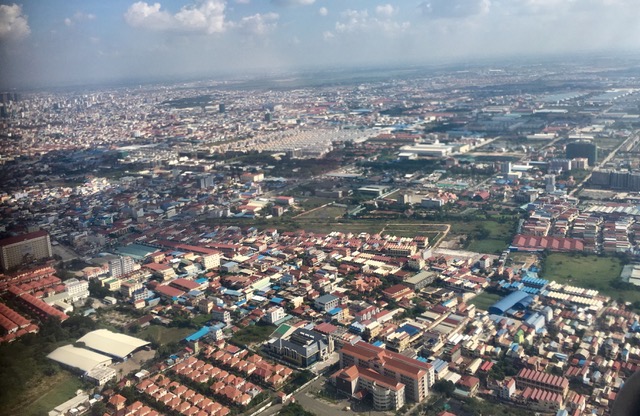






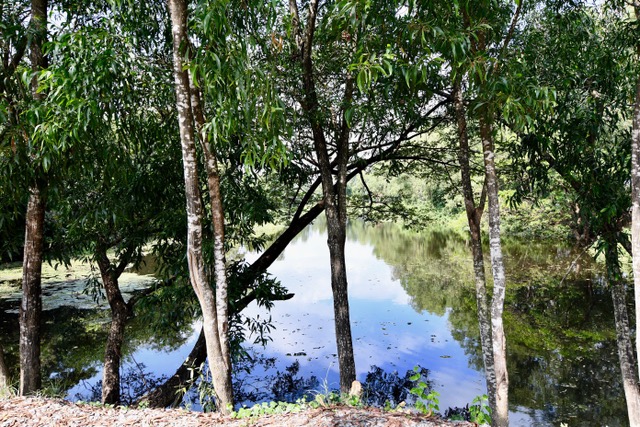










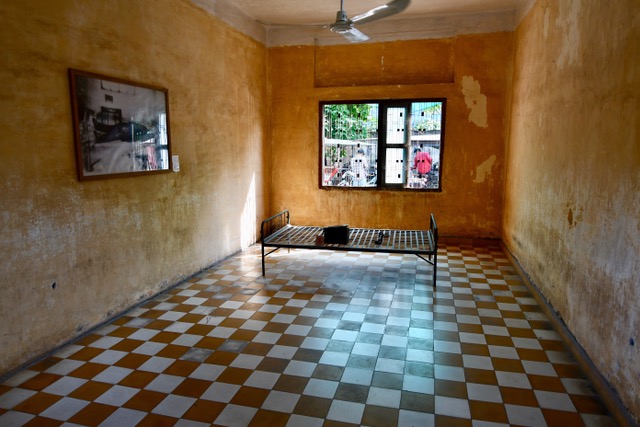
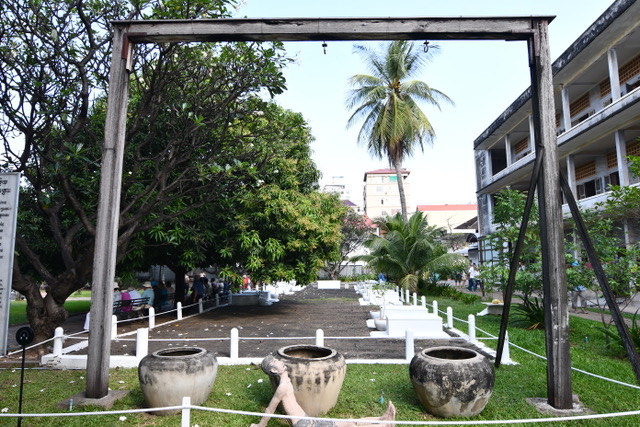
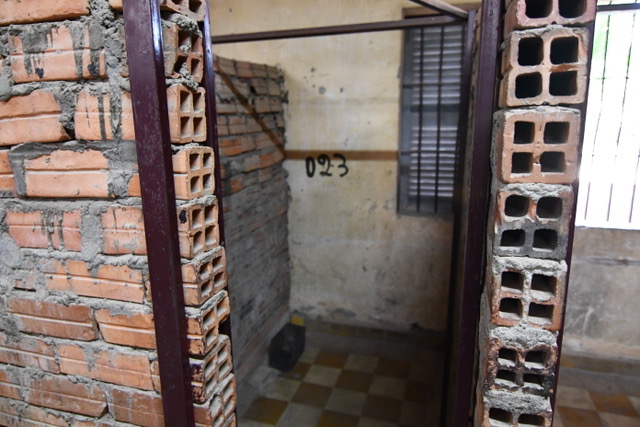










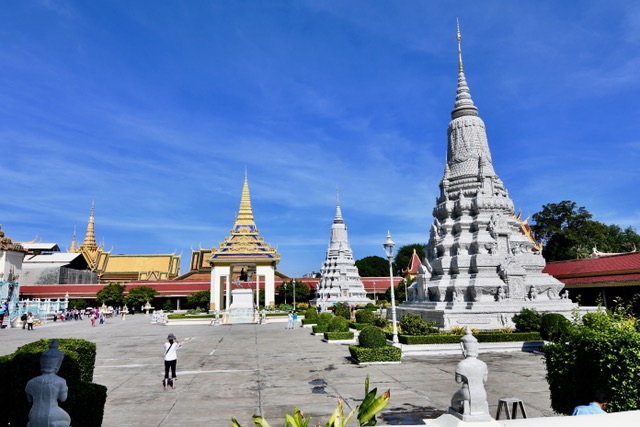
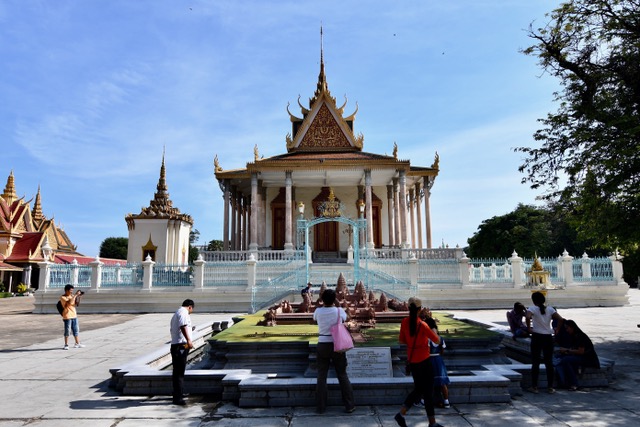


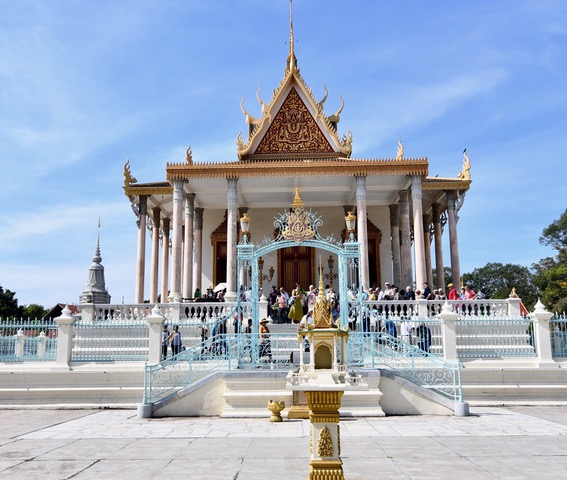

















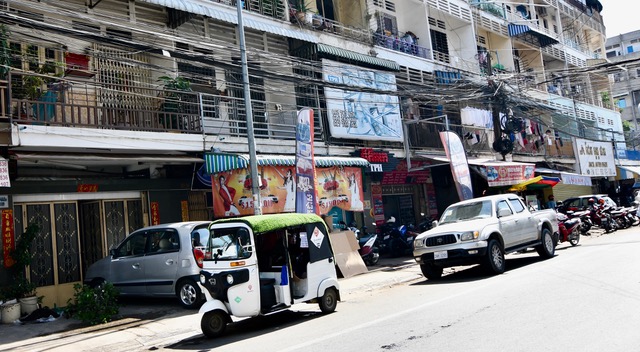










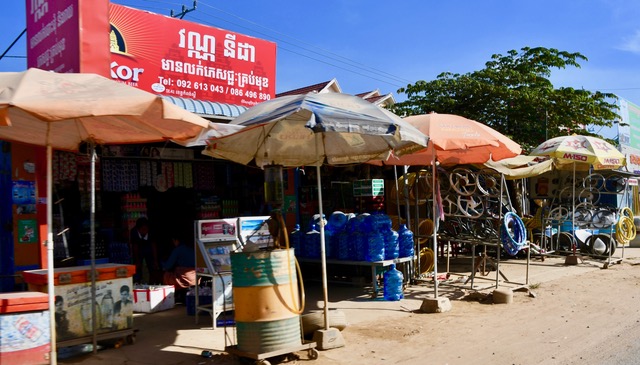





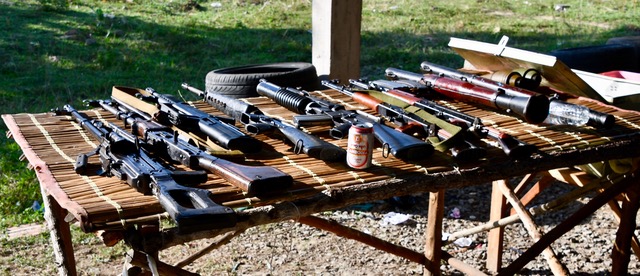




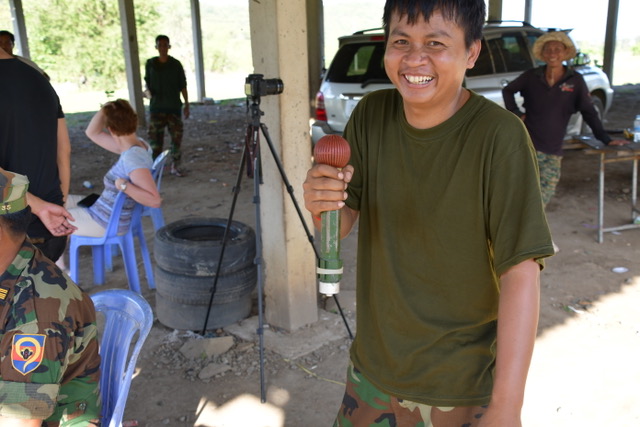




Thank you for the chronology on the genocide. I wonder if the Khmer Rouge were influenced by Mao’s cultural revolution. Like an uprising of rural against the urban cultural elite?
We’re saving the temples for next visit.
Wow! Very mixed feelings reading this blog. Good to know that the people seem happy, and are friendly. But what a lot of contrasts. Don’t think I’ll be putting Cambodia on my to-do list!
Thanks for the detailed sharing, the wonderful photographs, and the video. Xxx
No Angkor Wat etc? I thought this would be right up your street
I was in Cambodia and spent 3 of the 5 weeks I was there in phnom penh in December 2001. I adored Cambodia both sad and beautiful and to this day retains a piece of my heart.
how about you bring me back those door knockers..love ’em !!!!!